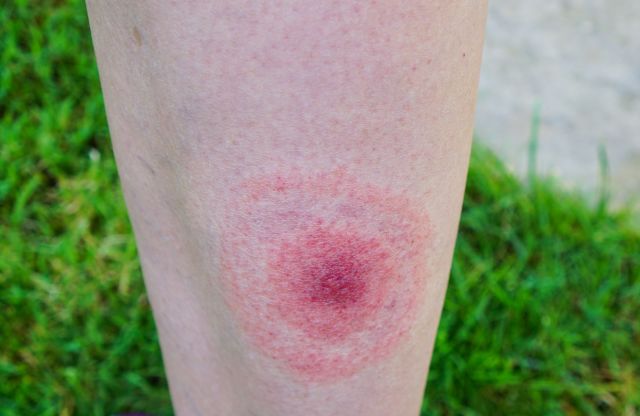Updated on July 17, 2024.
Each year, an estimated 476,000 people in the United States will come down with Lyme disease. Only around 63,000 cases are actually reported, however, according to the Centers for Disease Control and Prevention (CDC). The good news is that Lyme disease is preventable and treatable, especially if caught early.
Here’s what you need to know about this increasingly common infection.
Lyme disease at a glance
Lyme, an inflammatory disease that can affect multiple organs in your body, is caused by a bacterium called Borrelia burgdorferi, or B. burgdorferi. It’s transmitted through a bite from a tick. It’s the most common vector-borne illness in the U.S. (A “vector” is an organism that transmits an infection to another living thing.)
There are hundreds of species of ticks in the world, but only one species in the U.S. transmits the bacterium that causes Lyme. That’s the blacklegged tick, also known as the deer tick.
Although it’s possible to get Lyme disease anywhere in the U.S. except Hawaii, nearly all reported cases of Lyme disease occur in 16 states or districts, from Virginia through the northeast states and as far west as Minnesota.
But just because you found a tick on you doesn’t mean you will contract Lyme disease.
“The tick usually has to be on your body for 24 to 48 hours before it will transmit the disease,” says Michael Zimring, MD, a specialist in travel medicine at Mercy Medical Center in Baltimore, Maryland. “If you get the tick off properly, you probably won’t get the disease.”
Furthermore, you can only get Lyme disease from a tick that’s already infected. Regardless, it is important to remove a tick carefully and quickly because other diseases can be transmitted more quickly from a tick bite than Lyme. This includes Powassan virus, which is quite rare, but which can be transmitted in as little as 15 minutes after a tick attaches.
The risk for Lyme disease is highest when ticks are in the nymph stage, just before they become adults, between April and July. Although the prevalence of B. burgdorferi infection is twice as high in adult ticks, 90 percent of human disease transmission occurs from nymph ticks. That’s because ticks in this life stage are so abundant in the summertime when people are outdoors. They’re small, too, which makes them hard to spot on your body.
Understanding the phases of Lyme disease
There are three phases of Lyme disease. Knowing these can help explain how the infection is transmitted:
Early localized disease
Within three to 30 days after a bite from an infected tick, you may notice the classic “bull’s-eye” rash, called erythema migrans. This occurs in 70 to 80 percent of people with Lyme.
“You can have a large rash with a clear center, but it doesn’t have to be a clear center,” Dr. Zimring says. “It can be multiple rashes without a clear center.”
The rash may be accompanied by a fever. Other common symptoms of Lyme disease include headache, fatigue, swollen lymph nodes, and achy muscles and joints.
Seek prompt medical treatment if you have symptoms and are in an area that has deer ticks. You should also seek medical attention even if you don’t actually recall getting bitten by a tick. Most Lyme patients with early disease do not remember being bitten.
Early disseminated Lyme disease
Without treatment, about 60 percent of patients will move onto the disseminated Lyme disease phase. In these cases Lyme disease spreads through the body via the blood or lymph system. When it does, it most commonly causes musculoskeletal or neurological symptoms. These may include:
- Pain and swelling in the joints
- Nerve numbness or pain
- Bell’s palsy (facial paralysis)
Other symptoms may include heart palpitations, chest pain, and shortness of breath. In some cases, the disease may also cause heart or eye problems.
Late disseminated Lyme disease
At this point, bacteria have spread throughout the body and can even cross the blood-brain barrier (meaning they can enter the brain). At this stage, a person may experience neurological symptoms like migraines, dizziness, cognitive issues, and numbness and tingling for months and years after being bitten.
Treating Lyme disease
There’s no vaccine for Lyme disease, but there is good news: There are effective treatments for Lyme disease that can cure the disease in almost all cases.
The challenge is that if Lyme disease is left untreated for a very long time, it can cause permanent damage to the body that can’t be undone.
Seek medical attention as soon as possible
Treating Lyme disease as soon as possible is key to making sure there are no lasting effects. If you think you’ve had any chance of being exposed to Lyme-carrying ticks and you’re experiencing typical Lyme disease symptoms (such as the bull’s-eye rash, headaches, fever, or chills), see your healthcare provider (HCP) right away.
After physically examining you and talking with you about your tick exposure and symptoms, they may give you a Lyme disease test. They may also go directly to treatment, since treating Lyme disease sooner is always better and because the tests for Lyme disease may only work after a person has been infected for several weeks.
Zimring says if a patient was in a tick-heavy area and has symptoms, he wouldn’t wait for the results of a Lyme test: “If I suspect a patient has Lyme, I’ll treat it with doxycycline or another antibiotic.”
The standard treatment for early localized Lyme disease is 10 to 14 days of antibiotics. Some treatment for early disseminated disease lasts up to 21 days. With early antibiotic treatment, the prognosis is usually good.
With more advanced stages of Lyme disease, antibiotics may still work, but they may need to be given intravenously (through a vein) if the symptoms are severe. They may also need to be given for much longer. For example, if a person is experiencing swelling of the joints due to Lyme disease, they’ll likely be put on antibiotics for four to six weeks.
Understanding ‘chronic Lyme disease’
After treatment, 90 to 95 percent of people with Lyme disease will recover completely, according to the CDC. Occasionally, longer periods of symptoms might occur. You may have heard this referred to as “chronic Lyme disease.”
It’s not clear, however, whether this longer illness is caused by Lyme disease or not. As a result, the CDC calls it Post-Treatment Lyme Disease Syndrome (PTLDS). While the origins of PTLDS are unclear, it may have something in common with the extended periods of symptoms that sometimes follow other infections, as in the case with “long COVID.”
It’s important not to take antibiotics for longer than recommended by your HCP. Most people with prolonged symptoms will still recover completely, even if it takes several months.
Preventing Lyme disease
While prompt treatment for Lyme disease is often highly effective, the best approach is preventing it in the first place. That starts with avoiding ticks.
Take precautions
Although ticks can be an issue all year long, they’re most troublesome and plentiful between April and September.
“If you’re out in wooded areas, avoid high grasses and stay in the center of the path,” says Zimring.
Wear protective clothes when outdoors during tick season. This includes wearing long sleeves and long pants if you are hiking in woods or tall grass. Apply a repellent on exposed skin and over clothes that contains one of these important ingredients:
- DEET
- Picaridin
- IR3535
- Oil of Lemon Eucalyptus (OLE)
- 2-undecanone
- Para-menthane-diol (PMD)
Always be sure to read the application instructions carefully.
In addition to a repellent, it’s a good practice to apply a product containing 0.5 percent permethrin on clothes and gear or buy pre-treated clothing.
Look for and remove ticks
After being outdoors, check your entire body for ticks, especially warm, moist areas, such as the groin and under the arms. Check your scalp, in your hair, and in your belly button, as well. Parents should check their children—and don’t forget family pets who have been outdoors.
If you find a tick, remove it promptly. Use small tweezers and grab the tick as close to the skin as possible. Pull straight up without twisting the tick. You can also tie a fine thread or even unwaxed dental floss around the tick’s mouth parts, then pull upwards. Clean the area thoroughly with alcohol or soap and water.
“Make sure you get the whole head and try not to squeeze it,” says Zimring. Seek out medical help if you don’t believe you were able to remove the entire tick. If you find a tick on your clothes, put your clothes in the dryer on high heat for at least 10 minutes and for longer if the clothes are damp.







